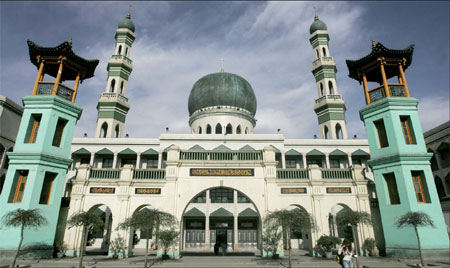Breath of fresh air
Updated: 2013-05-03 08:29
(China Daily)
|
|||||||||||
|
Dongguan Mosque, the biggest mosque in Qinghai province, is the main Islamic education center in northwest China. Provided to China Daily |

With its quiet pace of life and blue skies, Xining is an ideal summer retreat that combines the best of the big city and the countryside
Sitting at the entrance to the Qinghai-Tibet Plateau and as the gateway to the region by train, Xining is well traveled. It is the start of a journey into a largely Buddhist area, which for most Chinese is swathed in mystery, yet the city itself has a very different feel to the areas further west due to its position as a hinge between regional cultures, with a particularly strong Islamic feel.
The capital of Qinghai province is perhaps the least happening big city in China if measured by its economic force, but in terms of fresh air, religious culture and idyllic pace of life, it is definitely among the top. And for many chasing a quieter life, with countryside nearby, as well as the infrastructure of a modern city, it is the perfect spot.
Even the little bustle there in downtown can be easily left behind within a few miles as the city gives way to flocks of sheep grazing on grassland below deep blue skies.
An important stop along the old Silk Road, Xining also offers visitors an array of historic relics and ruins with a distinctive feel forged in the furnace of cross-cultural relations between Persian merchants and local Chinese, an interaction that led to the birth of the city.
Xining is a highland city 2,260 meters above sea level, but it escapes the harsh conditions of Tibet because it is sheltered by undulating mountains to the north that give it a mild climate throughout the year. Because of this, it is known as an ideal summer retreat across China.
The best way of reaching the city is by train, which offers stunning views along its route.
Here are some of Xining's main attractions:
1. Qinghai Lake
Around 150 kilometers from Xining, Qinghai Lake is China's largest inland and salt water lake, covering an area of 4,500 square kilometers.
Its clear water is attached to a legend about Wen Chen Konjo, a Tang dynasty princess, who was married to Srongsten Gampo, the Tibetan king. According to the tale, Wen took out a mirror during a trip to Tibet and saw a vision of her hometown in it. The image moved her to tears and she threw the mirror away during her journey. Where the mirror landed, Qinghai Lake was created.
When cattle and sheep dot the green grassland and surrounding mountains in spring and summer, the lake's surface ripples continuously as a result of migrant birds nesting on its islands. This is the best time for bird watchers.
In winter, it is blanketed with snow at times, and at others, its frozen surface shines like a giant mirror reflecting the blue sky.
2. Ta'er Monastery
Around 25 km southwest of Xining, Ta'er Monastery is in an area known as the birthplace of the Gelugpa Sect, a branch of Tibetan Buddhism, and was the center for both its monks and followers.
Its first buildings erected in 1379 in commemoration of Tsong Khapa, a famous teacher of Tibetan Buddhism, with major additions in 1577, it now covers an area of more than 14 hectares on the side of Lotus Mountain. Its 9,300 rooms and 52 halls are a spectacular view from the mountaintop.
The monastery is a combination of Han and Tibetan architecture, with lofty temples at different heights and an air of both mystery and grandeur.
When the monastery bell rings and resounds across the mountainside, it adds an extra touch of serenity to the whole scene.
At the center of the structure stands the Great Hall of the Golden Roof, its colorful gates carved with flowers and gems.
In front of it is the Great Hall of Meditation, where the monks gather to meditate. Its pillars are decorated with religious inscriptions and on its four walls hang pictures depicting the story of Buddha.
The monks also mold sculptures using butter, a traditional art form in this part of China, which are placed both inside and outside the hall.
3. Dongguan Mosque
Built in 1380, Dongguan Mosque is the biggest mosque in Qinghai province. It serves as the highest-level Islamic education center in northwest China.
The prayer hall covers an area of 1,136 square meters and can hold more than 3,000 people. During important Islamic festivals, thousands of followers gather here to worship.
China Daily
(China Daily 05/03/2013 page23)
Today's Top News
List of approved GM food clarified
ID checks for express deliveries in Guangdong
Govt to expand elderly care
University asks freshmen to sign suicide disclaimer
Tibet gears up for new climbing season
Media asked to promote Sino-Indian ties
Shots fired at Washington Navy Yard
Minimum growth rate set at 7%
Hot Topics
Lunar probe , China growth forecasts, Emission rules get tougher, China seen through 'colored lens', International board,
Editor's Picks

|

|

|

|

|

|






